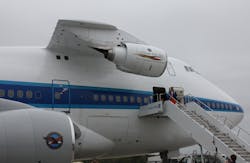Last week while attending the Pratt & Whitney Media Day event at the company headquarters in Hartford, CT, I along with others had the pleasure of going on-board one of the two Pratt & Whitney Boeing 747SP aircraft used for flight testing of turbine engines. The two 747SP aircraft are based at the Mirabel Airport near Montreal, Canada.
A focus of the event was the recently developed Pratt & Whitney Geared Turbo Fan (GTF) engine. It was explained that prior to the GTF new turbine engines used for flight testing had been fitted into one of the normal engine positions of the 747SP. Not the case with this model GTF. A specially designed wing-like pylon was constructed which protruded horizontally from the right side of the SP’s upper deck. At the end of this wing-like pylon fastened the flight test engine.
The cabin of the 747SP was configured into workstations, each having dedicated flight test engineers and technicians, monitoring and measuring thousands of parameters as part of the flight test and new engine certification process. Flight test engineers explained to the group some of the data collection that takes place during the sometimes eight hour flights around a triangular pattern, and some of the unique characteristics of the flying engine test bed.
I was reminded of my former airline days, decades ago when some of the Boeing 747 Classics had what was referred to as the fifth-pod position, a mounting point between the number two engine and the fuselage (if I remember correctly) designed to mount a spare engine and ferry it from one location to another. Ah…the good old 74 classic.
Click here to read about the Pratt & Whitney GTF engine on page 6 in the February/March issue of AMT.




